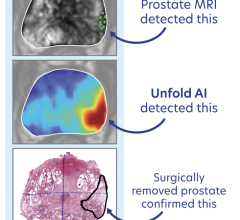August 21, 2019 — Physicians at the Froedtert & the Medical College of Wisconsin (MCW) Clinical Cancer Center in Milwaukee have treated the first cancer patient in the world using Accuray’s Radixact System with Synchrony motion tracking and correction technology. The patient was a 45-year-old man with lung cancer. With the addition of Synchrony, the Radixact System was able to track the lung tumor in real time as it moved with the patient's breathing and automatically adjust the radiation beam to keep it targeted on the tumor. This enabled the clinical team to deliver the maximum dose of radiation they felt necessary to destroy cancer cells, while minimizing the risk of damage to surrounding healthy tissues. The Radixact and CyberKnife systems both feature the Synchrony automated motion tracking and correction functionality.
The Froedtert & MCW Clinical Cancer Center, part of the Froedtert & MCW Cancer Network, is dedicated to using advanced treatment options to provide personalized treatments for every cancer patient. The clinical team installed the Synchrony upgrade because they wanted to further enhance the ability to deliver precise radiation treatment to their patients requiring this form of cancer therapy.
"The Froedtert & MCW Radiation Oncology team continues to identify and integrate technical advancements that have the potential to make radiation therapy treatment as precise, safe and effective as possible," said Christopher Schultz, M.D., FACR, FASTRO, Medical College of Wisconsin professor and chairman of the Department of Radiation Oncology with the Froedtert & MCW Cancer Network. "We have successfully treated the first patient, diagnosed with a lung tumor, using the Radixact System with Synchrony technology. With Synchrony, we were able to use a smaller treatment field when delivering radiation to the tumor as it moved. Without this technology, larger treatment fields would have been necessary to treat the entire path of the tumor movement. Alternatively, a much longer treatment time would have been needed to turn the radiation beam on and off as the tumor moved in and out of the specified treatment window. Overall, we believe that the addition of Synchrony to our Radixact System will expand treatment options for patients with mobile tumors, including those that are currently too large to treat without motion tracking."
"In our hospital network we've seen an increase in the use of hypofractionated stereotactic body radiation therapy as part of the cancer treatment, making it critically important that we are able to safely deliver the correct amount of dose precisely to the tumor, even to those that move such as tumors in thorax, abdomen and pelvis," said X. Allen Li, Ph.D., Medical College of Wisconsin professor and chief of medical physics at Froedtert Hospital. "Our comprehensive pre-treatment tests and the initial patient treatment showed us how well the Synchrony technology works in the real-world clinical practice. As a result, we now have an option for precisely and accurately delivering radiation to tumors as they move, which will expand the range of tumors we can confidently treat and the patients we can help."
Synchrony for the Radixact System is designed to correct for tumors that move as a result of bodily processes, including respiration and digestion, as well as patient movement. The technology uses image guidance during treatment delivery to automatically adjust the movement of the radiation beam in synchronization with the movement of the tumor. The beams of radiation are delivered continuously throughout the treatment session as the patient breathes naturally. In comparison, gating methods deliver radiation only when the tumor is close to the expected location and pause treatment delivery when the moving tumor is outside of the "treatment window." This potentially lengthens the treatment time and can compromise clinical efficacy.
Additionally, the combination of Synchrony with the Radixact System facilitates the efficient and effective delivery of both hypofractionated and standard radiation therapy, making it easier for clinical teams to provide treatments tailored to meet each individual patient's needs. This functionality directly supports the key priority of value-based healthcare delivery models, such as an alternative payment model, that economically reward treatment quality and efficiency to improve patient outcomes.
For more information: www.accuray.com


 April 12, 2024
April 12, 2024 








